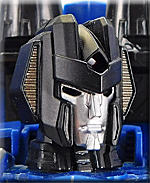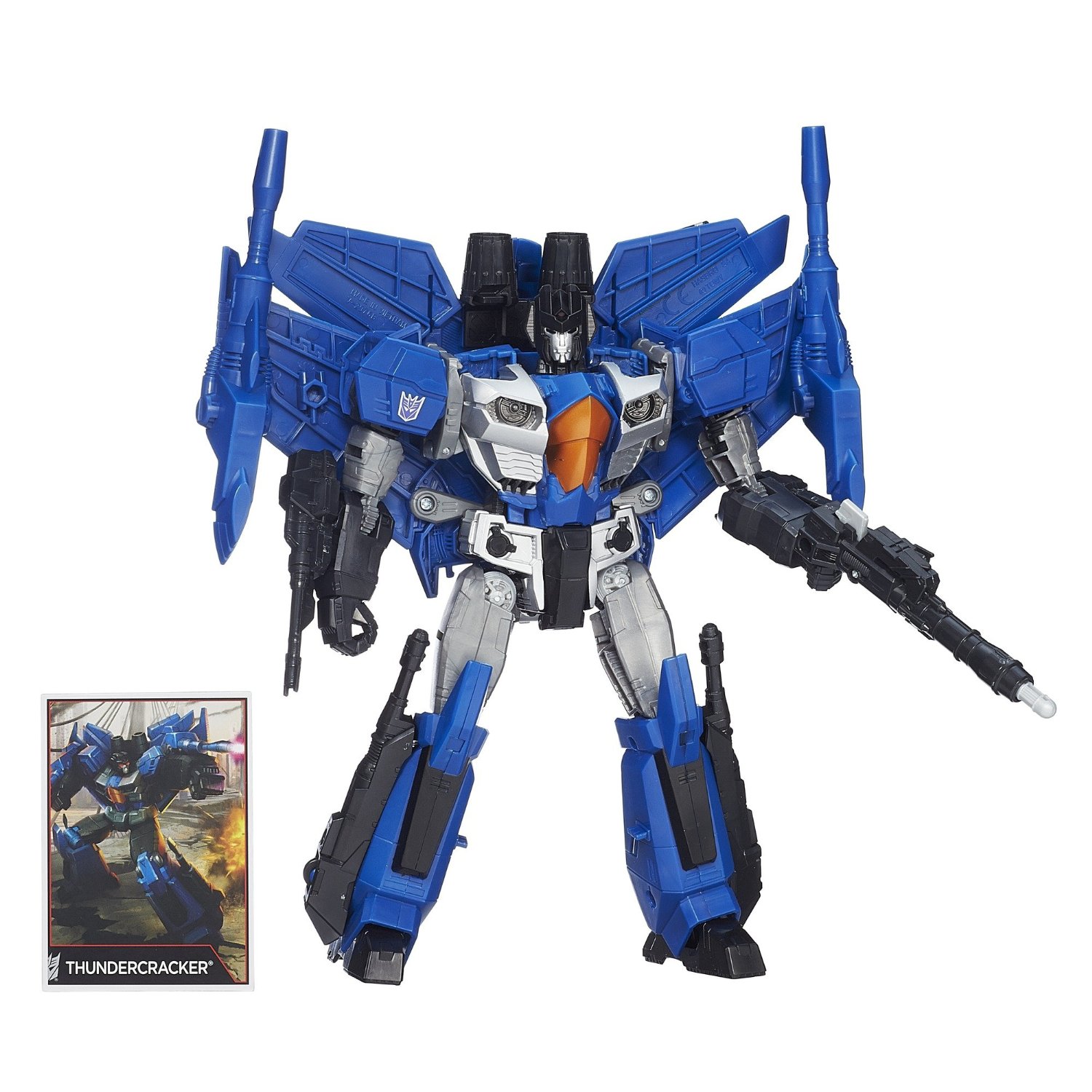
General Information:
Release Date: June 2015
Price Point: $45.99 (depending on retailer)
Retailer: General (Toys R Us, Target, Wal-Mart etc.)
Accessories: Arm cannons x 2, Leg cannons x 2, Blasters x 2, Missile launcher, Missile
Official images and text below in italics are from Amazon.com:
 Thundercracker lives on fear. Special materials in his jet frame allow him to unleash controlled sonic detonations that can be heard 200 miles away. Streaking across the sky at Mach 6, he wants his enemies to hear him before they see him. He wants them to know he's coming, and cower in fear at their impending doom. The war between Autobot and Decepticon rages on, and with Thundercracker in the fight, the action gets more intense all the time! This awesome Thundercracker figure is a massive force for evil in robot mode with an enormous arsenal of blasters and other weapons. But when it’s time for an airborne assault, he converts to a supercharged jet! Get ready for a whole new generation of Transformers mayhem with this incredible Thundercracker figure! Transformers and all related characters are trademarks of Hasbro.
Thundercracker lives on fear. Special materials in his jet frame allow him to unleash controlled sonic detonations that can be heard 200 miles away. Streaking across the sky at Mach 6, he wants his enemies to hear him before they see him. He wants them to know he's coming, and cower in fear at their impending doom. The war between Autobot and Decepticon rages on, and with Thundercracker in the fight, the action gets more intense all the time! This awesome Thundercracker figure is a massive force for evil in robot mode with an enormous arsenal of blasters and other weapons. But when it’s time for an airborne assault, he converts to a supercharged jet! Get ready for a whole new generation of Transformers mayhem with this incredible Thundercracker figure! Transformers and all related characters are trademarks of Hasbro.
In late 2014, Hasbro released a new Jetfire action figure as part of its "Thrilling 30" line, celebrating the 30th anniversary of the Transformers toy line. This was a whole new sculpt and full of accessories, so it was only logical that Hasbro would want to reuse the base sculpt if possible. As part of the Leader Class assortments in "Combiner Wars", the base Jetfire figure was retooled and given new weapons and deco as the three key "Seekers" from Generation One. The first of these was Thundercracker. This review will focus on the changes made to the sculpt for this release. Check out my Jetfire review for a detailed look at the original sculpt this figure is based on.
Packaging:
Thundercracker is packaged in a large window box. In true "Generations" style the box has mostly a black background. On the right side is the vertical "Transformers" logo with the "Generations" logo above it. The figure is in robot mode inside the box. Overlapping the figure is Thundercracker's artwork with his name underneath. The side of the box has a larger look at the artwork. The back of the box features the figure in both modes indicating 17 steps for his transformation. There is also a bio written up in several languages.
Accessories:
Thundercracker inclues several of the accessories that came with Jetfire. This includes the smaller blasters, leg weapons and the missile launcher. Each of these is cast in black plastic (the trigger on the missile launcher is silver). Thundercracker does not however include the rocket packs that attached to Jetfire's back. Instead, he has two large arm cannon. These are based off the arm cannons found on the G1 Seekers but much bulkier. I really like this interpretation of these classic weapons. They look super powerful while retaining elements of their classic design.

Robot Mode:
"Combiner Wars" and "Titans Return" have both shown that Hasbro and Takara Tomy have taken retooling (and "partial tooling" as Hasbro has called it) to new levels and Thundercracker is proof of that. The designers did not just slap on a new head and call it a day. Instead several parts of the base Jetfire figure have been replaced with new parts for this release. These include:
- The head sculpt is a new one based on the classic G1 Seeker head design. It features a small crest in the middle, two raised sections above it and vents on the sides of the head. This design is a bit more narrow and sleek than other examples of the Seeker head design and I think it looks great.
- The wings on the back are new pieces. More on this in the vehicle mode review.
- The shoulders are new pieces. Instead of the cylindrical shoulders used on Jetfire they are more boxy and wide.
- The chest features all new parts. The center looks like a cockpit, but it is not actually part of the vehicle mode (the real cockpit is on his back). The parts that flank the "cockpit" are sections with turbines inside. These are thinner versions of the chest designs featured in the classic Seeker design.
Amazingly all it took was changing the parts mentioned above to um...transform this figure from one character into another. The sculpt looks bulky, sleek and powerful all at the same time.
Thundercracker's plastic colors include: dark blue, gunmetal grey, silver and black. The colors are pretty well distributed throughout the body and the layout is partly inspired by his G1 deco (such as the shoulders being blue while the rest of the arms are gunmetal grye and black. The paint colors used on this figure include silver, gunmetal grey and orange. The silver is the most heavily used color. It is used to paint most of the torso area and the waist/hip section. Black is found on the legs. The gunmetal grey can be found on the turbines inside his chest. A tampographed purple and silver Decepticon symbol is printed onto the right shoulder. The orange is used for the faux cockpit window on his chest. Interestingly, the eyes are translucent red plastic, and if you shine a light behind the head you will see the light piping effect. This is not something that is used very often in Transformers figures anymore so it is nice to see from time to time. I like the deco. It calls back to G1 Thundercracker and looks great.
There are seventeen points of articulation on this figure. This includes four on each arm and leg. Thundercracker has all the same connection points as Jetfire. He has 5mm ports on the following points: the fists, the ends of the wings, the sides of the forearms and the sides of each leg. This allows you to attach all his weapons at the same time. You can also take the weapons and connect them all together to form a super weapon (Jetfire also had this ability). While Thundercracker does not have the rocket packs that came with Jetfire, he does still have the slots on the back to attach them.
Transformation to Vehicle Mode:
- Detach all the weapons and set them aside for now.
- Straighten out the arms and legs.
- Swing the cockpit section on the back up.
- Swing the section with the stabilizer fins up.
- Swing the feet back into the lower legs.
- Swing the arms out to the sides.
- Swing the shoulder panels down.
- Pull the Chest forward and down.
- Swing the arms up, straightening out the panels/ bars that connect to the arms.
- Swing the arms down and straighten them out.
- Swing the legs out at the waist sections.
- Rotate the legs so the front of the legs face inward. Bend the legs at the knees two notches.
- Swing the legs all the way up. There are tabs on the legs that connect to corresponding slots on the bottom of the horizontal stabilizer fins.
- Push the chest/head section up. There are panels on the back that flip up. Once you have pushed this up all the way, swing those panels down.
- Push the cockpit section down.
- Swing the vertical stabilizer fins up.
- The weapons can attach in various ways. You can use the 5mm ports on the bottom of the wings and the legs.

Vehicle Mode:
The vehicle mode underwent less extensive retooling than the robot mode. The wings are the new parts but that is enough to differentiate this vehicle form from Jetfire's. Instead of wings that sweep forward and back, these wings angle back to points, resembling the wings seen on the Seekers in the G1 cartoon. The other details such as the pointed noseone and the stabilizer fins in the back help complete this image. From a sculpting standpoint most Transformers fans would instantly recognize this as one of the Seekers.
This mode mostly shows off the blue plastic. Translucent yellow plastic is used for the cockpit cover. Like Jetfire the inside of the cockpit features two sculpted seats with an impressive amount of detail for a mass release figure. The vertical fins are black plastic and the nosecone is soft black plastic. Red, silver and black paint are used to provide extra detailing. The vertical fins have silver and red stripes, a detail inspired by G1 Thundercracker's stickers in the same place. The wings have a lot of red in the middle with silver outlining the red in the front. On top of this is a large Decepticon symbol on each arm, a detail also inspired by G1 Thundercracker. Silver paint is used on the front section flanking the back of the cockpit area. Black paint is used on the "frame" of the cockpit window. The seats and control panels inside the cockpit are gunmetal grey. The deco looks great and I appreciate how it calls back to G1 Thundercracker while still doing its own thing on the wings.
The arm weapons and the smaller blasters can attach to the bottom of the wings. The leg blasters can attach to the bottom of the jet where the rear wheels are located. The missile launcher can attach to the bottom of the nosecone, though it winds up sticking out in the front quite a bit.
Final Thoughts:
Thundercracker is a good example of swapping out some parts and giving a sculpt a new deco to represent a whole new character. Both modes are true to the original character in terms of deco and design. There are plenty of Thundercracker figures on the market (see my list above) but if you have been looking for a large one to loom over your Autobots, this is recommended if you can get it around the original retail price or cheaper.
Pros:
- New tooling is very effective in changing the Jetfire sculpt into Thundercracker.
- Good deco with nice callbacks to the G1 character.
- Ability to combine weapons or use them in different ways is fun.
- The details inside the cockpit are gorgeous, and being able to open it is a really great bonus.
Cons:
Some fans may not care for a Seeker in this size class.